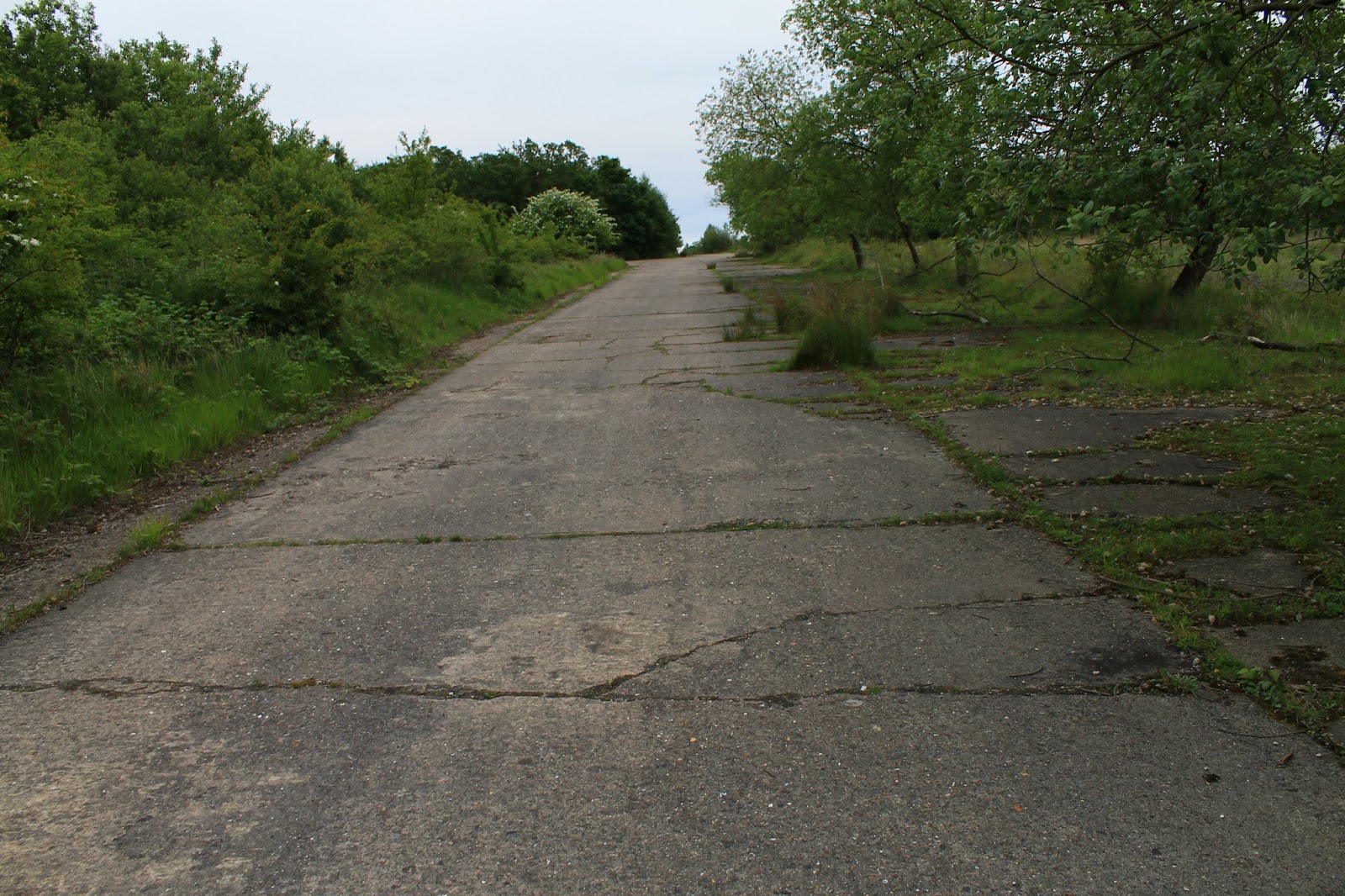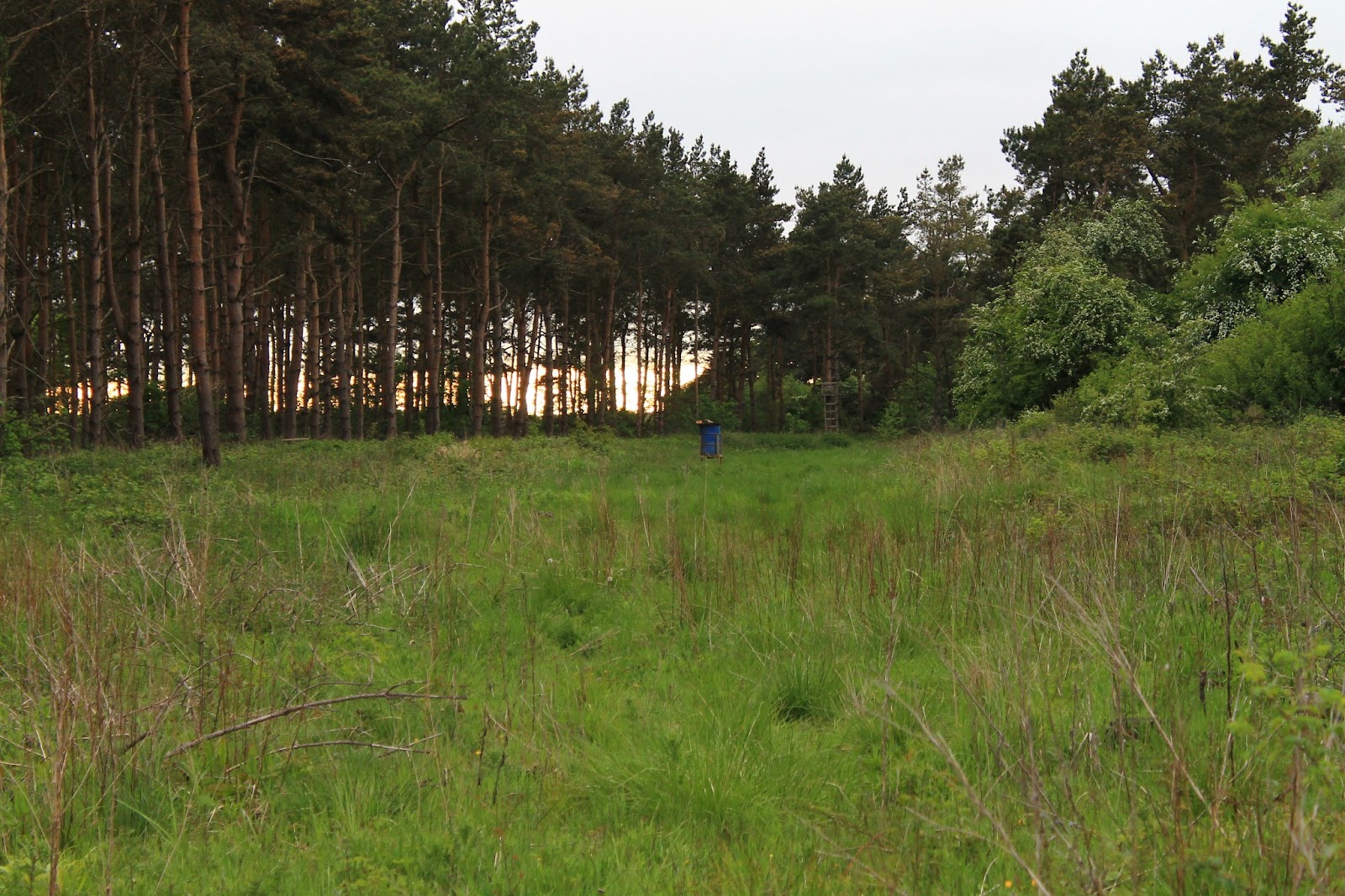 |
| RAF North Witham. Runway 20. |
"Just go behind a bush" my dad had said when I told him I needed the loo.
So I walked around some trees that had grown up in the middle of the runway and came face to face with a dozen deer, I could have reached out and stroked them they were that close. I'm not sure who was more surprised, me or them.

 |
| Site of a T2 Hangar. |
I was 11 when I lost my dad to lung cancer, but a lot of my memories of him are of roaming through woods with him, the above story happened on a work party to Tyford Wood. He volunteered his time to Butterfly conservation, and was always working in some forest or meadow in Lincolnshire. It just so happened that two of these places in a previous life were airfields, RAF Bardney was one, now Austacre wood and Tyford Wood, also known as RAF North Witham.
Although it wasn't until much later that I researched the site and re visited in the summer of 2009.
When the site was finished in late 1942, it was originally earmarked for 5 Group Bomber Command, the large numbers of US forces present in the area meant it was then allocated to the 9th Air Force and RAF North Witham officially opened on the 15th of December 1943.
The Airfield became home to the 1st Tactical Air Depot. In March 1944 the Pathfinder school which had been located at near by RAF Cottesmore arrived. In the Spring of 1944 select paratroopers from the 82nd and 101st Airborne Divisions arrived at North Witham to train at the Pathfinders School.
At 21:54 on June 5th 1944 C-47 NO. 293098 of the 9th Army Air Force's Troop Carrier Group carrying 101st Airborne Division Pathfinders, took off from North Witham making history, they became the first D-day wave.
The next 3 aircraft
followed five minutes later and so on until the last 3 took off at 22:20.
The next lot of C-47s carrying the 82nd Pathfinders took to the sky's
for their mission ("Boston") beginning at 23:02.
 |
| Two C-47s flying at Duxford's 2013 Spring Air Show. |
Captain Frank Lillyman of the 101st became the first man to be dropped over Normandy, although another Paratrooper form his stick beat him to the ground*. Their job was to set up portable Aldis lights and radar/radio beacons for the main wave of paratroops to locate their own drop zones for the main airborne assault.
"Albany" had "Mission Accomplished" at 00:46.
All but one Aircraft returned to North Witham (or other airfields in England) safely, and the lost plane made a textbook ditch at sea with all on board rescued by the HMS Tartar with no injuries and returned to England. Although some of the C-47s were hit and damaged by small arms fire and flak.
339 paratroopers out of the 357* landed at the correct drop zones, minus the 18 that were in the C-47 that ditched at sea.
The 1st TAD and all associated USAAF units left North Witham in May 1945 although elements had begun to depart as early
as December 1944. It passed back into the care of the RAF and after the 7th of May 1945, it became a bomb storage site, the runways and any available
concrete piled high with munitions and casings.
 |
| Post war bomb loading ramp visible on the right of the photo (taken 2009). |
 |
| Another shot of the ramps (taken 2009). |
In October the RAF Regiment used it briefly for disbanding personnel returning from overseas and for training, ending on the 5th June 1946.
It was used for storage into the 1950's and by February 1960 all the land had been sold, with the forestry commission taking back the woodland they gave over in 1942.
 |
| RAF Folkingham. |
In 1960/61 the runways once again echoed the sound of engines as the BRM Racing Team used it to test their cars when RAF Flokingham closed it's runways to them when it was brought back into service during the cold war as a Thor missile site.
 |
| Bomb store roads. |
 |
| North East Perimeter track. |
It seems like just another wood, when you pass by it going South or North on the A1. There's very little to be seen from the outside, but inside the trees it's a whole different story.
 |
| Light fittings |
 |
| Light fittings |
 |
| Light fittings |
 |
| 'Spectacle' dispersals. |
All three runways are still there, although they are not as wide as when in service and the concrete after 71 years is showing its age, in places the trees are starting to reclaim it. The perimeter track survives, as do many of the 'Spectacle' dispersals.
 |
| Control Tower. |


Hidden away in the trees stands the watch office/control tower.

I'm sat here writing this on the 5th of June 2013, contemplating a walk in the woods.
Bibliography
*Chorlton. Martyn, Paths in the wood, A complete History of RAF North Witham. 2003. Old Forge Publishing. http://www.amazon.co.uk/Paths-Wood-Complete-History-Witham/dp/0954450701/ref=sr_1_1?ie=UTF8&qid=1370443515&sr=8-1&keywords=Paths+in+the+wood
Otter. Patrick, Lincolnshire Airfields in the Second World War, 1996, Countryside Books.
http://www.6juin1944.com/assaut/aeropus/en_page.php?page=after_pathf_101
https://www.airspacemag.com/daily-planet/pilot-who-led-d-day-invasion-180951679/?fbclid=IwAR01Yca7gplB5eKP9qe-2aFQEEgML-YAdO-8xwYgK63Hv18pbfPqZb9SSJM
All photos taken by myself in 2009 and 2012.
The above is a very brief history of the site. For a full history I highly recommend Martyn Chorlton's book, Paths in the wood, available from the link above.

